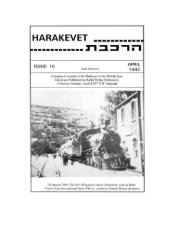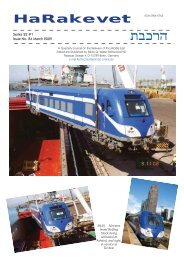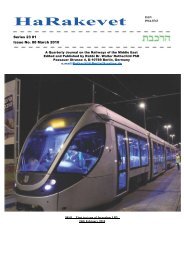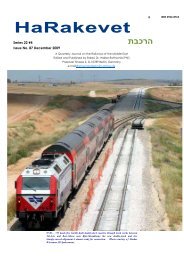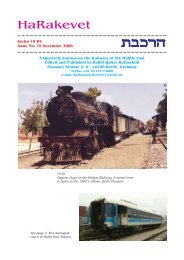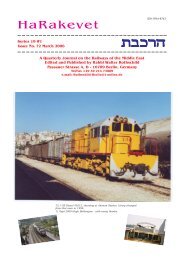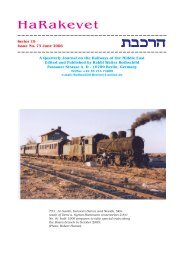You also want an ePaper? Increase the reach of your titles
YUMPU automatically turns print PDFs into web optimized ePapers that Google loves.
(xxi). INQUIRY INTO LEVEL CROSSING<br />
ACCIDENT.<br />
From a press release by the Ministry<br />
for Transport and Road Safety. The independent<br />
committee appointed by the Ministry<br />
to investigate the collision between a train<br />
and a minibus on 05.08.2010 north of Kiryat<br />
Gat, which cost the lives of four people and<br />
led to four injured, two of whom were rail<br />
passengers, has presented its conclusions.<br />
According to this the Railway authorities had<br />
made all appropriate level crossing precautions<br />
and it was the car driver who violated<br />
all regulations, including breaking through<br />
the barrier arms and ignoring all the warning<br />
devices installed. The Committee also apportioned<br />
blame to the two local Settlement<br />
Councils which had put obstacles in the way<br />
of preparing access roads for an overbridge<br />
- which could otherwise have been completed<br />
before this accident occurred.<br />
(xxii). EILAT HIGH-SPEED LINE.<br />
From a press release of 22.101.2010<br />
by the Transport & Road Safety Ministry:-<br />
Minister Katz issued today a Request<br />
for Information (RFI) for implementation<br />
of construction of the fast rail link to Eilat.<br />
The purpose of publishing such an RFI was<br />
to check the interest of the private sector<br />
in the project. and ascertain how the sector<br />
can become a partner in it - this includes<br />
design, construction, financing and operating<br />
the line.<br />
The project is currently being promoted<br />
as part of the nationwide ‘Israel Ways’<br />
project to link all parts of the country with a<br />
network of roads and railways from Kiryat Shemona<br />
in the north to Eilat in the south. This<br />
ambitious plan is to cost almost $7.6Billion,<br />
out of which $690M have been allocated to<br />
planning roads and railways. The line to Eilat<br />
will be 170km. long and of double track;<br />
along the alignment there will be 63 bridges<br />
with a total length of 4.5 km, and five tunnels<br />
totalling 9.5 km. The distance between Tel<br />
Aviv and Eilat will be 350 km.<br />
The line will have eight new stations:<br />
Hatzeva, Sapir Centre, Paran, Yahel,<br />
Yotvata, Timna (adjacent to the new airport<br />
now being promoted), Shekhoret and Eilat.<br />
The line is to be served by two sorts of trains<br />
- fast trains will cover the Tel Aviv - Eilat route<br />
in no more than 2.5 hours; stopping trains<br />
will call at the intermediate stations. The Ministry<br />
has checked six alternative alignments<br />
and selected the optimal one which runs via<br />
the Mount Tzin and the Arava. The project is<br />
currently being promoted statutorily through<br />
the District Planning Committee of the Interior<br />
Ministry. Survey and measuring works along<br />
the alignment are due to start soon. Surveys<br />
prepared by the Economics Planning Department<br />
of the Transport & Road Safety Ministry<br />
have found that the annual passenger traffic<br />
to Eilat is currently 8M, according to their<br />
forecast, passenger traffic by rail may reach<br />
3.5M annually.<br />
The line will also be used for freight<br />
traffic; from the port of Eilat directly to the<br />
centre of Israel. Traffic will include phosphates,<br />
potash ores etc, from the Negev and<br />
the Dead Sea north to Ashdod and Eilat, as<br />
well as imported cars which are currently<br />
transported by lorry. Current annual freight<br />
traffic to and from Eilat totals 2.5M tons of<br />
chemicals and 140,000 vehicles.<br />
Minister Katz said: Rail freight traffic<br />
has many advantages over road by reducing<br />
the number of lorries, the accidents in which<br />
heavy road vehicles are involved and the air<br />
pollution; not less significantly, this will significantly<br />
change the Israeli social and transportation<br />
map, thus bringing the periphery<br />
nearer to the centre.”<br />
OFFICIAL DOCUMENT PROPOSAL FOR<br />
THE EILAT LINE.<br />
The 20-page document includes (following<br />
are extracts):-<br />
2.1. Government Resolution No.<br />
1421 of 24.02.2010 instructed the Govenment<br />
to promote, inter alia, the design of a<br />
railway to Eilat.<br />
2.2. This is part of a broader programme<br />
known as ‘Netivei Israel’, a Transport<br />
Programme for the promotion of both the<br />
Negev and the Galilee, helping develop the<br />
peripheral areas by connecting them to the<br />
central region. The cost of the entire project<br />
is estimated at NIS 27.5 Bn. (€8.5 Billion.)<br />
2.3. Instructions are to examine different<br />
topographical alignment alternatives,<br />
recommending the optimal alternative to enable<br />
a travel time of no more than 2hr. 30 min.<br />
for an express passenger service between<br />
Tel Aviv and Eilat.<br />
2.4. The railway had the potential<br />
for economic viability as it can satisfy demands<br />
for freight transport from the Dead Sea<br />
and Negev area (chemicals and fertilizers) to<br />
Eilat, and for freight transport between the<br />
Port of Eilat and the Port of Ashdod.<br />
2.5. The Min. of Transport has decided<br />
to examine the feasibility of contracting<br />
with the private sector to implement the<br />
project.<br />
3.1.2. Line Characteristics:<br />
Total double track length to be constructed:<br />
169km.<br />
Total length of upgrading to double track:<br />
88km.<br />
Number of bridges: 63. Total length: 4.5km.<br />
Number of tunnels: 5. Total length: 9.5km<br />
(1 cut & cover, 5.5km; 4 to be bored, 4km.<br />
(optional).<br />
Number of local stations: 7<br />
1 central station in Eilat.<br />
1 Depot and stabling provision.<br />
Infrastructure according to chosen power<br />
system (diesel or electric.)<br />
The following sections are involved:-<br />
Tel Aviv - Lod. 20km. Double track already exists<br />
and is being upgraded to 160km/h. Track<br />
,cfrv<br />
upgrade is not part of the project.<br />
Lod - Beer Sheva. 73 km. Double track is currently<br />
under construction and designed for<br />
160km/h. Track construction is not part of the<br />
project.<br />
Beer Sheva - Dimona. 34km. Existing track requires<br />
upgrading to 160 km/h and doubling.<br />
By the Concessionaire.<br />
Dimona - Zin. 54km. Existing track requires<br />
upgrading to 160m km/h and doubling. By<br />
the Concessionaire.<br />
Zin - Hatzeva - Eilat. 170km. New double<br />
track to be constructed and designed for<br />
speeds of up to 200 km/h. The Hatzeva - Eilat<br />
section to be suitable for speeds of 230<br />
- 300 km/h. By the Concessionaire.<br />
An optional short cut is possible, reducing<br />
the route length by 34km. The construction<br />
of the shortcut includes a total of 4km. of<br />
four double-track tunnels through the Zin<br />
Mountain, 10km. of double track and 10km.<br />
of single track. The shortcut tracks should be<br />
designed for 160km/h. By the Concessionaire.<br />
Rail Freight.<br />
Rail Freight services to be given by the Con-<br />
cessionaire:-<br />
Dimona - Eilat Centre, of materials originating<br />
in the Dead Sea; Eilat Centre - Ashdod Port<br />
via Beer Sheva. The Beer Sheva - Eilat section<br />
does not include the Zin shortcut due to vertical<br />
slopes [i.e. gradients] of 3%.<br />
Note: Freight services already exist from Dimona<br />
to Ashdod Port.<br />
Optional extension of the line from Eilat Centre<br />
southwards to the Port of Eilat. Length: 3<br />
km.<br />
3.1.3. Traffic Concept.<br />
The system allows a mix of passenger and<br />
freight rail traffic.<br />
Passenger Services:-<br />
The Project must offer passengers a fast, comfortable,<br />
reliable and safe journey. Passenger<br />
information systems must be provided, and<br />
disabled access guaranteed. Both regular<br />
and express services must be offered. The<br />
regular passenger service between Beer<br />
Sheva Center and Eilat will include 8 stops<br />
along the route: Dimona (existing), Hatzeva,<br />
Sapir, Paran, Yahel, Yotveta, Timna Airport and<br />
Shehoret. The passenger express-service begins/ends<br />
at HaHagana Tel Aviv station and<br />
ends/begins at the Eilat Transport Center, with<br />
a two-minute stop at Beer Sheva North station.<br />
Service frequency must be optional according<br />
to demand. Total travel time for the<br />
express service should not exceed 2hr. 30<br />
min. Freight service must guarantee safe transportation,<br />
in particular of hazardous materials<br />
such as chemicals. Frequency is not restricted,<br />
but must be integrated into the passenger<br />
service timetable.<br />
3.1.4. Demand Forecast.<br />
Based on an economic evaluation made by<br />
AB PLan Ltd., MATAT Ltd. and TOP Acoustics<br />
Ltd. in 2007 for the MOT:-<br />
Page



